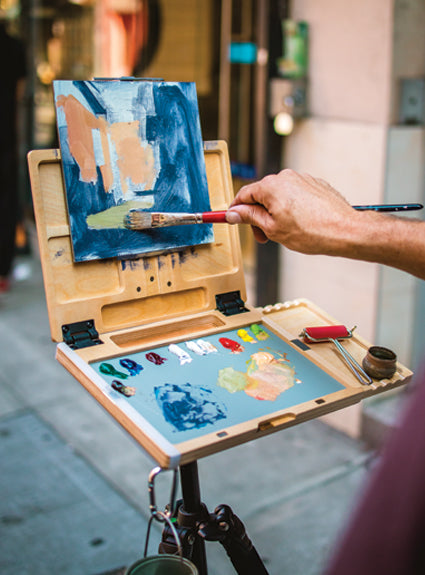INTERVIEW with ELLEN COOPER
LOCATION: Philadelphia, Pennsylvania
CAREER: Full-time painter - commissioned portraits and figurative painting. I teach at the Wayne Art Center and workshops upon request.
EDUCATION: BFA, Drawing and Painting; Tyler School of Art, Temple University, Philadelphia, Pa. MFA Scenic Design for the Theater, Temple University.
LITTLE KNOWN FACT: If I were not an artist I think the next best job would be to stay home and read. Do you think anyone would pay me to do that?
WHEN WAS THE MOMENT YOU KNEW YOU WANTED TO BE A PAINTER?
I knew I wanted to be an artist ever since I discovered my fascination with drawing as a young child. Drawing made me feel empowered, like I had some kind of handle on the world around me. Painting was a natural extension of drawing.
WHAT IS YOUR STYLE OF PAINTING?
Although I’m not necessarily thinking about having a particular style, the way I paint is categorized as realism. It seems that over time I am increasingly excited by and sensitized toward color and tonal relationships... that has got to factor in to my style in some way.
.
DID YOU HAVE A MENTOR OR SOMEONE YOU LOOKED UP TO?
I did not have the good fortune of a mentor, but was gratified to have instructors that pushed me beyond my limits and had me focus on discovering what I was capable of. First and foremost was my high school art teacher, Claude Falcone, a legend to all who knew him.
WHAT DO YOU LIKE MOST ABOUT WHAT YOU DO?
Getting "into the zone” with the paint and pondering, searching, working on the challenges I set up for myself, and seeing an idea come to life. I’m grateful for the wonderfully positive aspects of what I do as well as the negatives, because both are part of the very fortunate position I’m in... that of a full-time painter.
WHAT IS THE LARGEST HURDLE IN THE ARTS YOU HAVE HAD TO OVERCOME?
I think that would be the task of moving from my former job into painting full time. I needed to work on developing skills, a cohesive professional portfolio of work, and avenues to promote my work while still working at a job. It would have been less of a hurdle if I could have devoted myself to the transition full time without a worry about the income, but it was what it was. It took time and perseverance, but was so worth the effort.
WHAT IS ONE OF YOUR GOALS YET TO BE ACHIEVED?
I’ll always be working on goals. Currently I’ve set my sights on creating a body of work for a gallery show.
WHAT IS THE MOST IMPORTANT LESSON YOU HAVE LEARNED FROM PAINTING?
One of the most important, and recent, lessons is the awareness of opaque and transparent paint to describe the sense of light on form. I recall standing in front of a Cecilia Beaux painting and seeing an area of the painting that was describing a woman’s sleeve. The use of transparent and opaque paint in that area was so effective and dimensional that I felt as if I could stick my hand into the painting and it would actually have dimension. And yet, it was just paint, and a very abstract looking passage for that matter. That experience pointed the way to finding a new vocabulary with my paints.
WHAT ADVICE WOULD YOU PROVIDE TO ANYONE ASPIRING TO PAINT PROFESSIONALLY?
Look into the future to see where you want to be and set goals. Meet those goals and set new ones. Stop at nothing. If you love what you do, the time invested, the challenges, and the pitfalls just become part of the endeavor.
DO YOU HAVE A BOOK OR DVD THAT YOU WOULD RECOMMEND?
I just have books of the painters that inspire me – it’s like having friends and mentors around me.
DO YOU HAVE A FAVORITE PAINTER?
There are so many painters past and present that I admire. From the past; Vermeer, Holbein, Sargent, Velazquez, Degas, Uglow, Morandi. From the present; Antonio Lopez Garcia, Kanevsky, Desiderio... the list goes on and on.
WE HAVE TO ASK... WHAT IS YOUR FAVORITE NEW WAVE PALETTE?My New Wave palette is the
Expressionist. It’s lightweight and effortless to hold; the size and shape are perfect for me to lay out my colors, and still have plenty of mixing room. In the past year I switched from a palette laid on top of my taboret to the hand-held New Wave Palette. I really like having the palette in front of me, between me and my painting surface and between me and my subject, so that I can see all of the colors right up there and in the right context. It makes the challenge of working toward the right values and colors so much easier.
.
-Ellen Cooper










